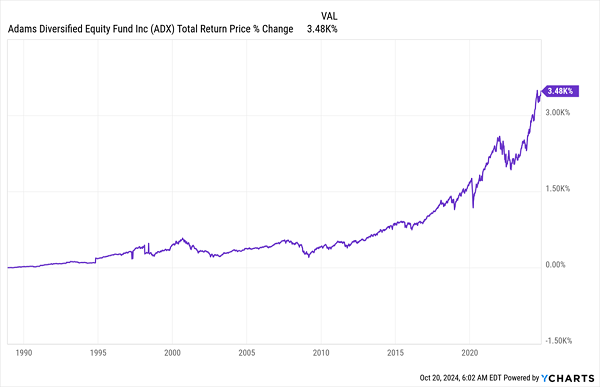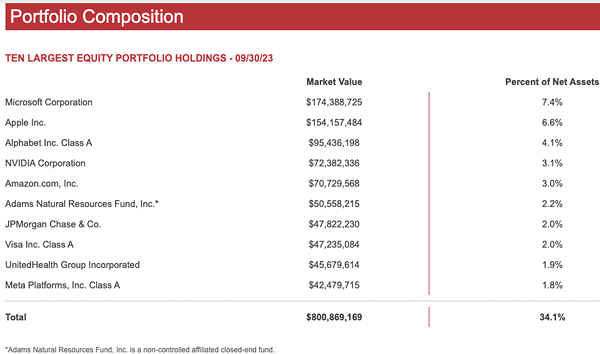I get it if you’re a bit wary of this latest market rally: We’ve got a volatile (to say the least!) election nowadays away. And while the Fed says rates are headed lower, there’s still a lingering uncertainty about where, exactly, they’ll land.
While a bit of anxiety is understandable, we do not want to make the same mistake many “vanilla” investors do at times like these: go all into cash.
For one, humans are terrible at predicting the future—remember those warnings of a 100% chance of a recession in 2023?—so safe to say a good number of today’s investment worries are unlikely to come to pass.
Worse, for us dividend investors, going to cash carries an extra cost: We lose our income stream.
And if you’re in closed-end funds (CEFs), you stand to lose a lot of income indeed: CEFs yield around 8% as I write this, and the portfolio of my CEF Insider service yields even more: around 9.4% as I write this.
A Safe Option for 8%+ Dividends and Upside
Just as a fast aside before we go further: One thing that bothers me about the discussion around CEFs these days is that people who don’t know much about them talk about them like they’re speculative investments.
Nothing could be further from the truth: Fact is, CEFs are heavily regulated. Just like big companies, such as Microsoft (NASDAQ:MSFT), Home Depot (NYSE:HD) or Walmart (NYSE:WMT), CEFs must account for their operations and file statements with the SEC every quarter.
Even more reassuringly, most CEFs are managed by big financial institutions, which have a lot of investment resources at their disposal, as well as access to top portfolio-management talent and deep connections in the markets in which their funds operate.
So instead of going to cash, we’re taking a pragmatic, dividend-focused (and CEF-focused) approach to the potential volatility ahead: We’re going to:
- Zero in on undervalued CEFs outside the regular bond and stock sectors. Corners of the market like real estate investment trusts (REITs), which we discussed in last Thursday’s Contrarian Outlook article, are a prime example. The fund we talked about in that piece, the 7%-yielding Cohen & Steers Quality Income Realty Fund (NYSE:RQI), is a good way to buy REITs—which are already oversold—at a 2% markdown, so we’re basically getting two deals here. That latter figure, by the way, is RQI’s discount to net asset value (NAV, or the value of its underlying portfolio).
- Lean into CEFs that buy stocks but trade at deep discounts (while offering S&P 500-busting yields). For that, we’re going with a fund CEF Insider members know well: the Adams Diversified Equity Fund (NYSE:ADX), which yields around 8% today.
The first thing that jumps out about ADX (besides the dividend yield) is its age: This one has been around since 1929, so it’s weathered the Great Depression, Second World War, soaring rates, falling rates, financial crises, a pandemic, you name it.
(I’ve actually heard of some people who pass their holding in ADX down from generation to generation.)
Adams has parlayed its long institutional experience into a stellar total return for ADX—nearly 3,500% since late 1988:
ADX: Big Dividends and Decades of Strong Returns

This is where the fund’s value comes in, because as I write this, ADX trades at an 11.5% discount to NAV, letting us buy in below the value of its assets. (Or 11.5% less than where these stocks trade today, if you were to buy them “direct” yourself.)
This discount is a holdover from a few months back, when the fund had a policy of paying most of its dividend as a year-end special payout that could be difficult to predict.
Many CEF investors either didn’t understand the payout structure or were too impatient, so they left ADX aside. But management changed that policy and now will pay no less than 2% of NAV per quarter, for an average 8% yield on NAV. That should help ADX’s discount narrow, pulling its price up as it does.
And either way, ADX’s policy really amounts to “translating” its portfolio gains into an income stream for you and me. Given the general direction of the market is up over the long term, it’s fair to expect our payouts to rise in the long run, too.
Meantime, the fund’s portfolio is extremely modern. Its holdings have a strong tech bent, giving us a chance to buy rapid growers like Microsoft, Apple (NASDAQ:AAPL), Alphabet (NASDAQ:GOOGL), NVIDIA (NASDAQ:NVDA), Amazon.com (NASDAQ:AMZN) and Meta (NASDAQ:META) at that 11.5% discount.

Source: Adams Funds
Plus, as you can see, these top holdings also give us a smattering of non-tech names, like Visa (NYSE:V), JPMorgan Chase (NYSE:JPM) and UnitedHealth Group (NYSE:UNH).
The 8% yield means that an investment of $500,000 in ADX would kick out roughly $40,000 of annual income, allowing you to live off dividends while reducing the need to draw down your principal.
Here’s another fun fact: While the vast majority of that quadruple-digit return ADX has posted since 1988 was in dividend payouts that were then reinvested, the payout hasn’t hogged the entire spotlight: Shares traded for around $9.75 each back in 1988 and have more than doubled since: They’re around $22 now.
So, even if you took out all of those dividends and spent them to pay your bills, take vacations, invest elsewhere, whatever—you still saw your original buy double. Not bad!
“Amp Up” Your 8% Dividend to a Huge 10.5% Yield (Paid Monthly)
ADX perfectly illustrates one of the key advantages of CEFs: They give us the ability to buy great stocks at a discount that just isn’t available if we buy them ourselves, or through an ETF.
And, of course, we get CEFs’ big 8% average yields. But that’s just the average! Plenty of CEFs yield more—and they pay dividends monthly, too. Like the 5 monthly paying CEFs I’m urging all investors to buy now. They yield an outsized 10.5% today, and, as mentioned, they pay dividends monthly.
Now is the time to buy them and kickstart your own monthly (and 10.5%-yielding) income stream. Don’t miss out.
Disclosure: Brett Owens and Michael Foster are contrarian income investors who look for undervalued stocks/funds across the U.S. markets. Click here to learn how to profit from their strategies in the latest report, "7 Great Dividend Growth Stocks for a Secure Retirement."
